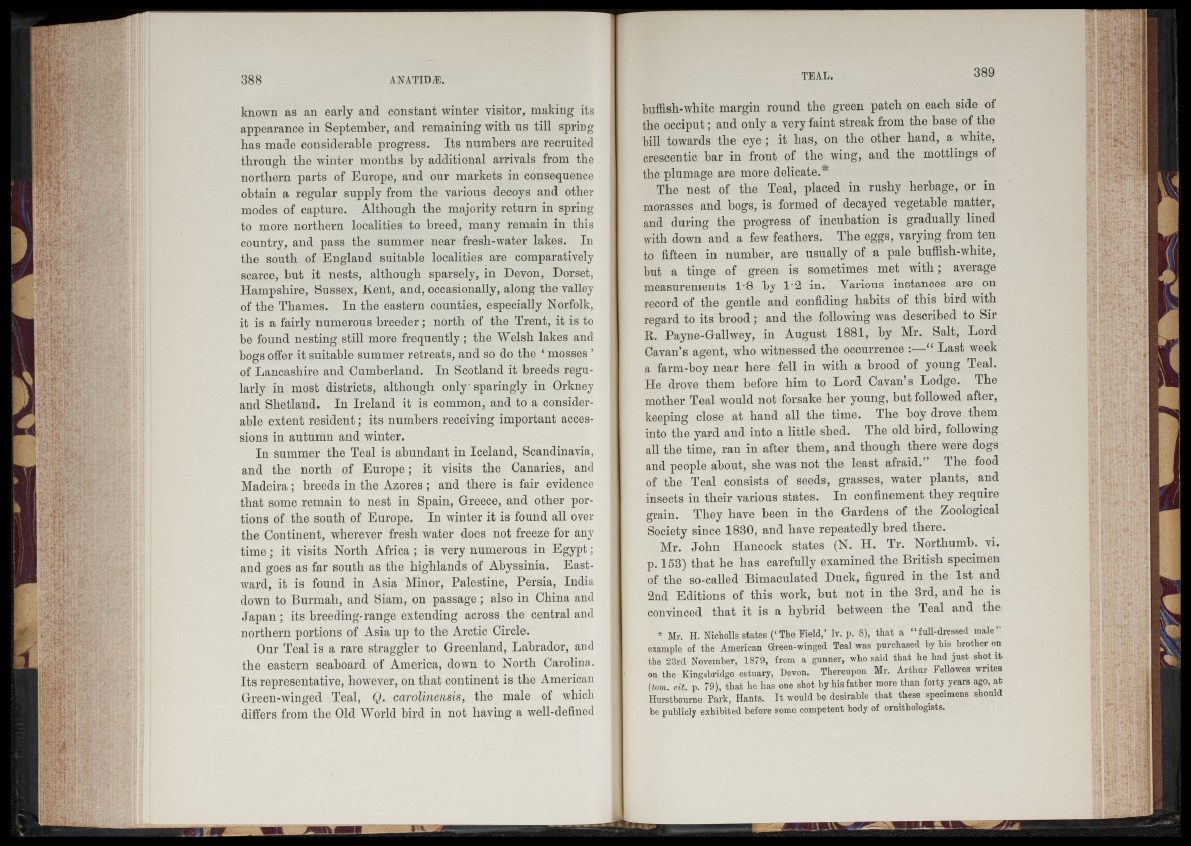
known as an early and constant winter visitor, making its
appearance in September, and remaining with us till spring
has made considerable progress. Its numbers are recruited
through the winter months by additional arrivals from the
northern parts of Europe, and our markets in consequence
obtain a regular supply from the various decoys and other
modes of capture. Although the majority return in spring
to more northern localities to breed, many remain in this
country, and pass the summer near fresli-water lakes. In
the south of England suitable localities are comparatively
scarce, but it nests, although sparsely, in Devon, Dorset,
Hampshire, Sussex, Kent, and, occasionally, along the valley
of the Thames. In the eastern counties, especially Norfolk,
it is a fairly numerous breeder; north of the Trent, it is to
be found nesting still more frequently; the Welsh lakes and
bogs offer it suitable summer retreats, and so do the ‘ mosses ’
of Lancashire and Cumberland. In Scotland it breeds regularly
in most districts, although only sparingly in Orkney
and Shetland. In Ireland it is common, and to a considerable
extent resident; its numbers receiving important accessions
in autumn and winter.
In summer the Teal is abundant in Iceland, Scandinavia,
and the north of Europe; it visits the Canaries, and
Madeira; breeds in the Azores ; and there is fair evidence
that some remain to nest in Spain, Greece, and other portions
of the south of Europe. In winter it is found all over
the Continent, wherever fresh water does not freeze for any
time; it visits North Africa ; is very numerous in Egypt;
and goes as far south as the highlands of Abyssinia. Eastward,
it is found in Asia Minor, Palestine, Persia, India
down to Burmah, and Siam, on passage; also in China and
Japan ; its breeding-range extending across the central and
northern portions of Asia up to the Arctic Circle.
Our Teal is a rare straggler to Greenland, Labrador, and
the eastern seaboard of America, down to North Carolina.
Its representative, however, on that continent is the American
Green-winged Teal, Q. carolinensis, the male of which
differs from the Old World bird in not having a well-defined
buffish-white margin round the green patch on each side of
the occiput; and only a very faint streak from the base of the
bill towards the eye ; it has, on the other hand, a white,
crescentic bar in front of the wing, and the mottlings of
the plumage are more delicate.7"
The nest of the Teal, placed in rushy herbage, or in
morasses and bogs, is formed of decayed vegetable matter,
and during the progress of incubation is gradually lined
with down and a few feathers. The eggs, varying from ten
to fifteen in number, are usually of a pale buffish-white,
but a tinge of green is sometimes met with; average
measurements 1’8 by 1*2 in. Various instances are on
record of the gentle and confiding habits of this bird with
regard to its brood; and the following was described to Sir
R. Payne-Gallwey, in August 1881, by Mr. Salt, Lord
Cavan’s agent, who witnessed the occurrence :—“ Last week
a farm-boy near here fell in with a brood of young Teal.
He drove them before him to Lord Cavan’s Lodge. The
mother Teal would not forsake her young, but followed after,
keeping close at hand all the time. The boy drove them
into the yard and into a little shed. The old bird, following
all the time, ran in after them, and though there were dogs
and people about, she was not the least afraid. The food
of the Teal consists of seeds, grasses, water plants, and
insects in their various states. In confinement they require
grain. They have been in the Gardens of the Zoological
Society since 1830, and have repeatedly bred there.
Mr. John Hancock states (N. H. Tr. Northumb. vi.
p. 153) that he has carefully examined the British specimen
of the so-called Bimaculated Duck, figured in the 1st and
2nd Editions of this work, but not in the 3rd, and he is
convinced that it is a hybrid between the Teal and the
* Mr. H. NichoUs states (‘The Field,’ lv. p. 8), that a “ full-dressed male’
example of the American Green-winged Teal was purchased by his brother on
the 23rd November, 1879, from a gunner, who said that he had just shot it
on the Kingsbridge estuary, Devon. Thereupon Mr. Arthur Fellowes writes
(tom. cit. p. 79), that he has one shot by his father more than forty years ago, at
Hurstbourne Park, Hants. It would be desirable that these specimens should
be publicly exhibited before some competent body of ornithologists.